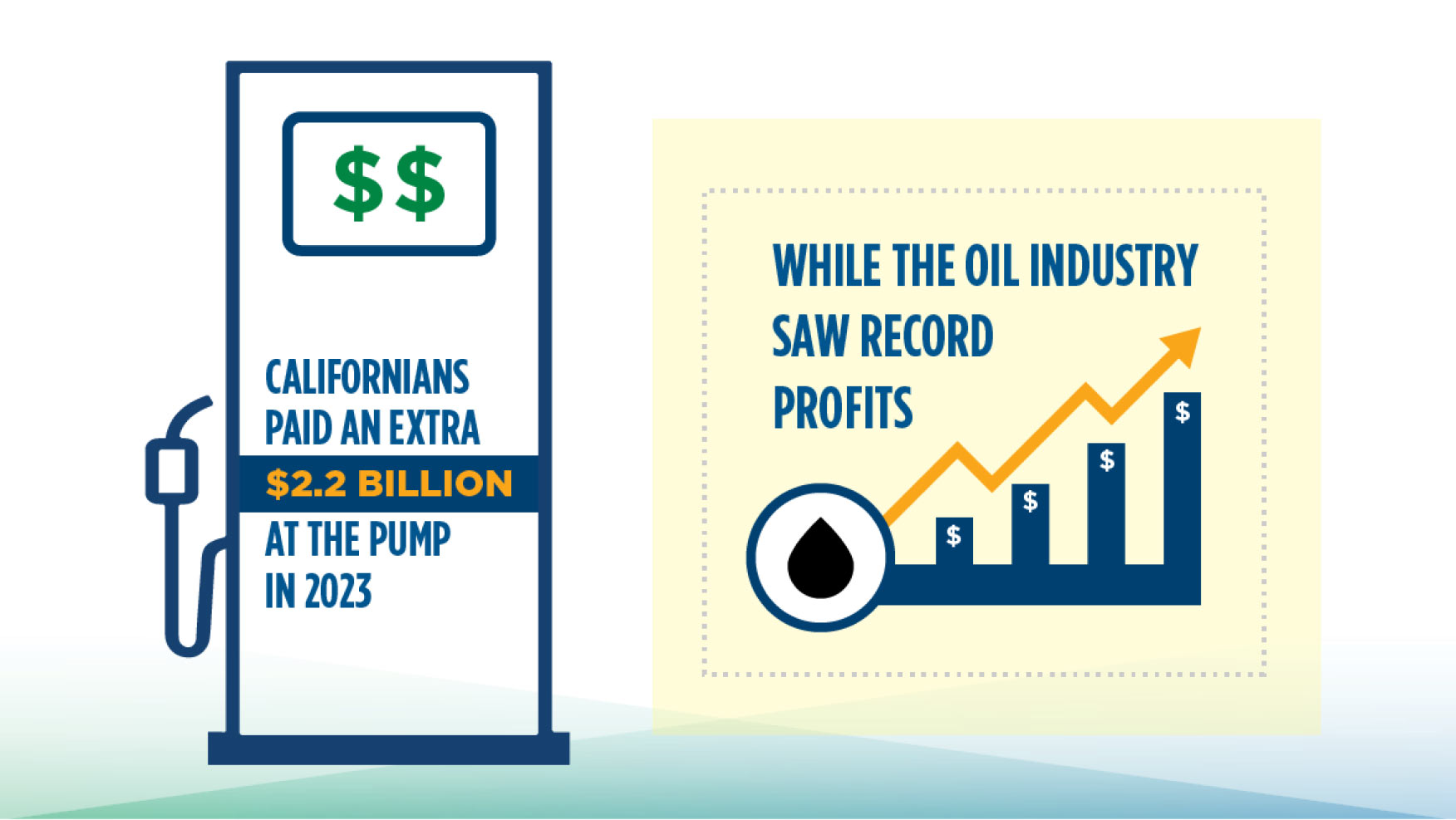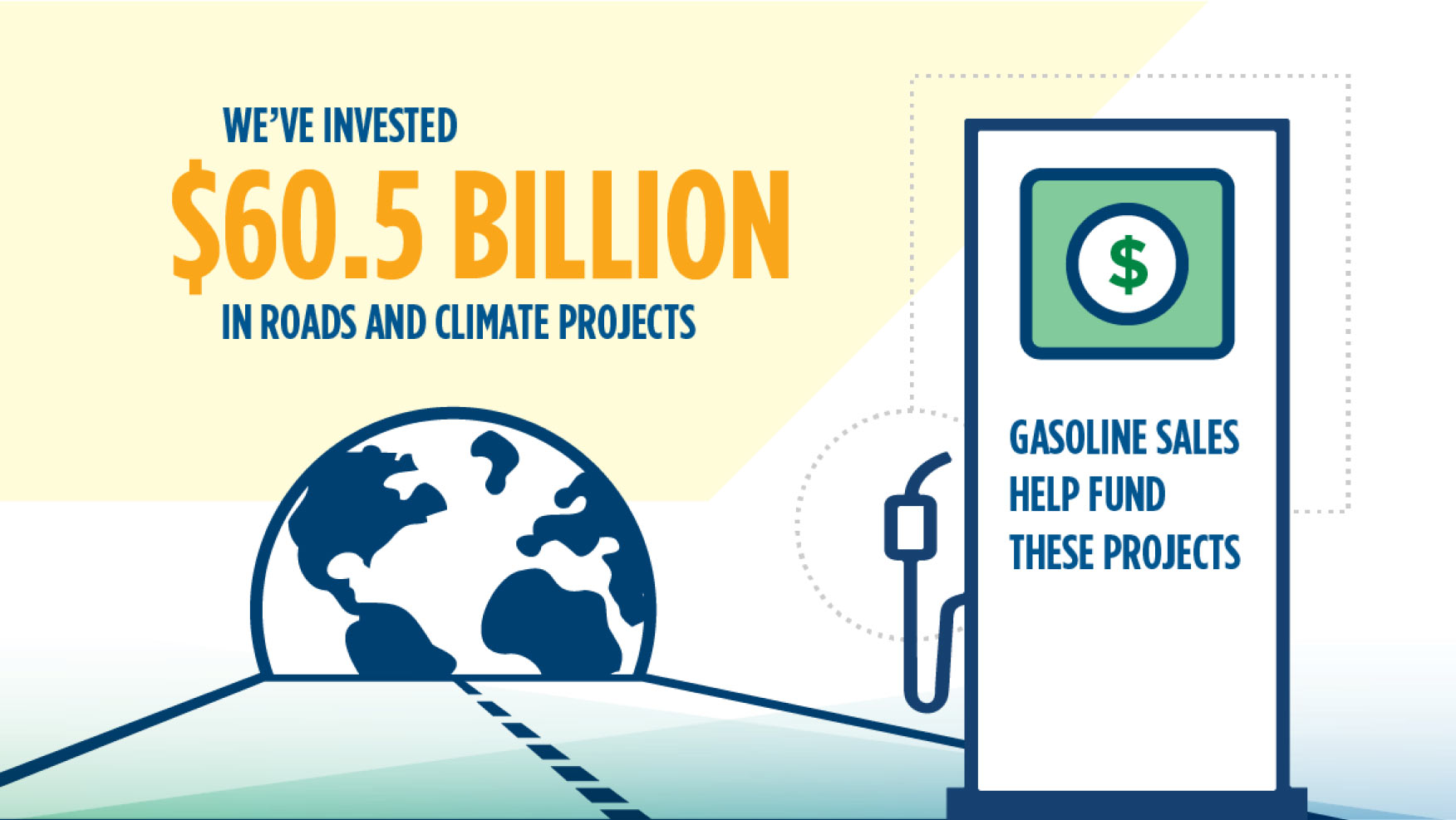California gas facts
California is acting to protect our people from gas price spikes. We’re working toward a future of cleaner air and better roads for all.

Fact: Price spikes at the pump are profit spikes for the oil industry.

California refineries go offline for maintenance with no plan for backfilling supply. This increases prices and oil industry profits. A new state law by Governor Gavin Newsom is working to fix this.
Fact: Rapid changes in gas prices are due to oil industry profits and costs.

California’s state taxes and fees don’t change day-to-day. Oil industry profits and costs do. The oil industry drives fluctuations in gas prices, including price spikes. Californians paid a record $2.61 more per gallon than the national average in 2022. Yet state taxes and fees stayed the same.
Explore what drives gas price spikes
Fact: Every gallon of gas you buy helps build better roads and funds climate action.

Cleaner fuels and charging polluters are essential parts of California’s climate plan. Proceeds from the state’s cap-and-trade program have raised $28 billion. We put this money into projects that fight climate change and cut air pollution.
Our climate policies will save Californians an estimated $200 billion in health costs by 2045.
California’s gas taxes also benefit residents by funding needed infrastructure.
Spotlight: California’s Low Carbon Fuel Standard
Have you heard of our state’s Low Carbon Fuel Standard? It’s a unique tool that cuts pollution and saves drivers at the pump. Here are some frequently asked questions.
What is the Low Carbon Fuel Standard?
The Low Carbon Fuel Standard (LCFS) was established by Governor Arnold Schwarzenegger in 2007 to diversify and expand California’s transportation fuel supply, decarbonize our transportation sector and improve air quality.
How does LCFS work?
It sets a declining carbon-intensity target for California’s transportation fuels. Fuel producers can choose to comply by:
- Meeting that target,
- Exceeding the target and earning “credits” by producing low carbon fuels, and in doing so, they can bank credits for the future or sell to other producers who have not met the target, or
- Buying credits from other producers to make up for any shortfalls in meeting their target.
This market-based approach lets producers find the most efficient way for their businesses to meet requirements, while creating a financial incentive for producers to develop cleaner fuels.
How much money does LCFS generate?
Every year, the LCFS generates $4 billion in private sector investment toward a cleaner transportation sector that reduces pollution and benefits Californians. Going forward, the LCFS will spur even more private sector investment in clean fuels.
What happens with the money that LCFS generates?
The program adds no revenue to state coffers; rather, it gets invested back into California communities. Farms are investing in methane capture technology to produce renewable electricity, biomethane, and hydrogen. UPS is investing in renewable natural gas vehicles that reduce emissions. EV companies like Rivian have put their headquarters in California because of programs like the LCFS. The nation’s leading airlines recently partnered with the state to use sustainable aviation fuels.
And alternative fuels are getting cheaper, thanks to LCFS. Renewable diesel, which was once more expensive than traditional fossil diesel, is now getting more competitive in price with its petroleum counterpart. Today, zero-emission vehicles are more affordable and increasingly common on California’s roads. This shift is a direct result of the LCFS creating a market where cleaner fuels can thrive, driving down costs and providing more options for consumers.
Does the LCFS save Californians money?
Yes. This private sector investment ultimately keeps money in Californians’ pockets through:
- Increasing consumer choices, which drives transportation fuel price competition
- Growing new industries and attracting investments that support jobs and strengthen communities
- Reducing dependence on petroleum, the oil industry, thereby protecting consumers from its associated supply and cost volatility
- Making electric vehicles more affordable
- Expanding access to electric vehicle charging and hydrogen refueling infrastructure
- Reducing health care costs associated with air pollution from fossil fuels
It’s made California a world leader in clean fuels and innovation, becoming a dominant economic sector for the state.
Will the updated LCFS program continue saving consumers money?
Yes. The updated program will increase economic benefits to Californians. For example:
- Californians should expect to see an estimated 42% reduction in total fuel costs per mile by 2045 — translating to savings of over $20 billion in fuel expenditures every year.
- For passenger cars, these fuel cost savings will be even more pronounced, cutting today’s costs to Californians by more than 50%.
- The amount of LCFS proceeds invested in disadvantaged communities for clean fuel and transportation projects is estimated to be approximately $4.8 billion over the next decade.
- Californians are expected to save almost $5 billion in health care costs by avoiding the impacts of air pollution.
How does LCFS impact the price of gasoline?
The LCFS regulations do not automatically raise prices at the pump.
When companies shift the cost of complying with the LCFS regulation to consumers, the self-reported data from fuel producers show Californians pay between $0.08 to $0.10 per gallon of gasoline for these clean fuel standards.
Oil companies do not have to shift these costs to consumers – there are other options for complying. This includes absorbing them as part of a firm's standard operational costs, purchasing credits from cleaner fuel producing firms or producing cleaner fuels themselves, which would allow them to generate credits for sale to other fuel producing firms. And in fact, some oil companies have already begun producing low carbon fuels themselves, in direct response to the LCFS.
Does LCFS raise gas prices?
No, the updated program does not automatically raise gas prices. In fact, it’s expected to help save Californians $20 billion every year collectively in lower fuel costs.
The vast majority of what people pay at the pump right now, especially during those price spikes we saw in 2022 and 2023, go towards Big Oil and their profits.
Does LCFS contribute to gasoline price spikes?
No. In fact, more production of cleaner fuels means less dependence on fossil fuels and foreign oil, which helps shield Californians from spikes in gas prices. And LCFS has displaced more than 30 billion gallons of petroleum fuel since 2011.
State agencies examined data on retail gasoline prices between 2019 and 2023. The LCFS and other environmental programs contributed to roughly 6% of the increase in retail gasoline prices during this time period. Federal, state and local taxes and fees accounted for 12%.
80% of the increase in retail gasoline prices during this time period went to oil companies.
State fees, taxes and environmental programs paid by gasoline consumers are re-invested in California and deliver benefits such as improved air quality, safer roads and improvements to public transit. This cannot be said for the other costs embedded in retail gasoline prices that consumers pay per gallon of gasoline.
Why are we hearing so much about the LCFS and gas prices?
Big polluters and their allies have spent millions of dollars to push a false narrative about California’s gas prices. Why? Simply put, they’re placing profits ahead of the needs of California consumers – allowing gas prices to spike by keeping supplies artificially low and reaping billions of dollars in doing so.
What happens if gas prices do go up?
Affordability remains a key consideration for the state. The Air Resources Board directed staff to assess any impacts of the recently updated policy on retail gasoline prices every year, beginning one year from the effective date of the changes to the LCFS.
Fact: California is working to combat gas price spikes.

With new tools, the state is closely tracking gas prices. We look at several factors, including gas supply and refinery maintenance.
We also have a new watchdog agency, the Division of Petroleum Market Oversight. It focuses on market oversight and identifying market manipulation by refiners.
California has also proposed a first-in-the-nation rule for refineries. It would require them to maintain a minimum inventory of fuel. They would have to responsibly plan for interruptions due to maintenance. This would prevent price spikes from artificially low supply when demand is high. Californians could save hundreds of millions, if not billions, of dollars.